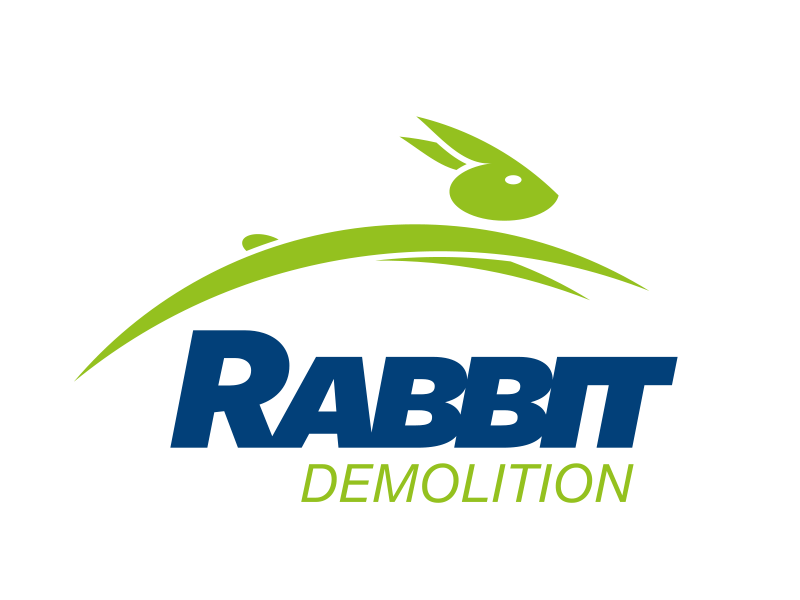Rabbit Demolition is the trusted choice for professional demolition site clearance, offering a full range of clearing and waste removal services to clients throughout Sussex and beyond.
Our team can provide a range of demolition options to suit the specifics of your site, then remove all unwanted materials using modern equipment and the highest levels of expertise, with every attention paid to relevant safety regulations.
Read on to learn more about what is involved in a demolition site clearance and how we minimise both risk and disruption on our projects.
The Demolition Process
There are four main stages to work through when undertaking a demolition project before the physical demolition and site clearance can begin. The stages are usually completed in this order:
Stage One: Surveying the building and surrounding area.
Stage Two: Removal of all hazardous materials on-site.
Stage Three: Health & safety considerations.
Stage Four: Demolition plans for the building/structure.
Stage Five: Demolition and site clearance.
This article will give you an overview of each stage of the process so you have a broader understanding of what’s involved in a demolition site clearance.
Stage One: Surveying and Risk Assessment
Long before beginning any demolition work, a demolition contractor must first undertake a thorough survey and risk assessment of the site. Through this process, several factors will be identified that the demolition company will later address. Risks that might be identified may include exposure to dust, heat and noise, so suitable measures must be put in place to provide ventilation and noise reduction.
The site survey and risk assessment findings will be used to hold a site induction that defines the demolition procedures to be employed and the worksite’s overall guidelines. The results of any risk assessment carried out will also be used in Stages 2 and 3 of the demolition process; Removing Hazards and Health & Safety.
Stage Two: Removing Hazards
In line with risk assessments and health and safety protocols, any hazardous material must be removed from the site, prior to demolition commencing. By doing this, we safeguard everyone who will be present on-site, including those who will use the new structure in due course.
Any highly combustible liquids and items must be removed from the site entirely unless they are a necessary part of the demolition process, while all fuels, lumber, and similar materials must be stored away safely.
If hazards, such as asbestos or radioactive metals are identified on-site, they must be safely removed by a specialist company. Likewise, if ground contamination is suspected, this must be addressed by specialists before demolition can begin.
Stage Three: Health & Safety Considerations On A Demolition Site
Demolition sites carry a higher than average risk of injury for both workers and passers-by. With that in mind, any firm that undertakes demolition site clearances must be acutely aware of its responsibilities in order to protect everyone on or near the site.
H&S considerations on a demolition clearance site will include such topics as fire and emergency protocols and essentials such as the use of PPE when onsite. Rabbit Demolition adheres to stringent safety procedures, following industry guidelines and best practices to safeguard our team, site visitors, and the general public.
Learn more about Health & Safety Advice For Demolition Sites.
Stage Four: Planning A Demolition Project
A well-laid-out plan is essential to the smooth running of any demolition project, ensuring that everyone involved understands the jobs to be completed and the expected timeline. A detailed demolition plan will include a wide range of site information, such as:
- The location of the building and relevant access information.
- Structural support systems within the building.
- Distances between the building and surrounding streets, structures and buildings, and any street furniture such as benches, bollards, or bus shelters that could potentially be affected.
- Type of demolition to be used and detailed sequences of how the demolition will be completed.
- Precautionary measures put in place to protect the public. This may include covered scaffolding, walkways, protective screens, safety nets, hoardings, catch fans and/or platforms.
- Clearance processes and equipment required for handling building debris after the demolition has been completed.
- Timeframe needed to complete the demolition.
Once the plan is completed, work can begin.
Stage Five: Demolition and Site Clearance
In the final stage of a Rabbit Demolition site clearance project, our team get to work, demolishing the site in line with the previously completed risk assessments, planning and H&S measures.
Whether the project involves total demolition or selective demolition using dismantlement, deconstruction or mechanical equipment, we will ensure the site is efficiently stripped, demolished, and cleared, ready to build on.
Demolition Site Clearance Costs
If you’re preparing for a construction project, whether large or small, our team of demolition site clearance experts offers a professional service at a competitive price.
Contact the team today for an obligation-free quote tailored to the scope of your demolition.






